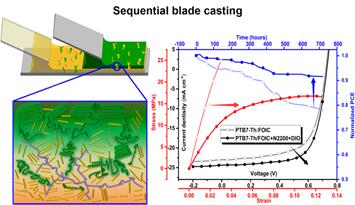Flexible wearable devices will have a transformative impact on the electronics industry in the future with their light weight, flexibility and excellent compatibility with printing and roll-to-roll processing. Organic solar cells (OSCs) used as wearable electronics should be able to withstand tensile strain of at least 20-30%. Benefited from the rapid development of non-fullerene acceptors, OSCs has achieved a highly power conversion efficiency (PCE) of over 17%. In order to further meet the needs of commercialization, attention must be paid on improving the mechanical performance of the device while achieving the high efficiency. It has been firmly established that microstructure of photoactive layer is closely associated with the efficiency as well as the stability and mechanical properties of BHJ devices. Careful morphology control can therefore provide effective pathways to co-optimize these properties of OSCs. Literature presents several contradictions in regard to achieving excellent efficiency and mechanical properties. Therefore, how to co-optimize the efficiency and mechanical properties of OSCs through precise morphology control is a hot topic in current research.

To solve these scientific problems, the researchers from organic photovoltaic materials & interface in State Key Laboratory for Mechanical Behavior of Materials of Xi’an Jiaotong University fabricated highly efficient P-i-N structure OSCs with excellent mechanical properties via controlled nanostructures of photoactive film using sequential blade-coated (SBC) strategy. Based on the optimized morphology, the inverted P-i-N device exhibits the highest PCE of 12.27% in comparison with the optimal PCE of 11.01% for the control of BHJ device. The superiority of P-i-N device can be attributed to the gradient donor and acceptor distribution formed during sequential deposition process. Moreover, adoption of SBC strategy here also resulted in thermodynamically stable film morphology, and thus improving the stability of the devices. Researches show that D/A interfaces will provide possible crack points when external stresses are applied, which is the performance-limiting component. The gradient distribution structure processed by SBC provided efficient D/A interfaces and purer phases. Consequently, the crack-onset strain (COS) of P-i-N film enhanced 6 times compared with the BHJ film. It is worth noting that the low-content N2200 can inhibit molecular diffusion by forming a fibril network, which is also beneficial in boosting the stability and mechanical properties of P-i-N devices. This work may direct the development of flexible wearable devices in the future.
These results were published of “Sequential Blade-Coated Acceptor and Donor Enables Simultaneous Enhancement of Efficiency, Stability, and Mechanical Properties for Organic Solar Cells” on Advanced Energy Materials. Prof. Wei Ma from School of Material Science Department of Material Physics and Chemistry is the corresponding author. Yilin Wang and Qinglian Zhu are listed as co-first author. The State Key Laboratory for Mechanical Behavior of Materials of Xi’an Jiaotong University is the only one corresponding institute.
Link for this paper:https://onlinelibrary.wiley.com/doi/full/10.1002/aenm.201903609


